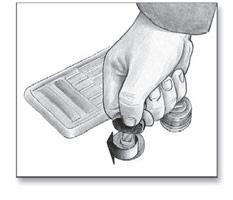
1 minute read
Starting the engine
ON
Before starting the engine in the morning, perform the Daily Service, see chapter 7. Remember to connect the battery main switch on the left hand side of the front fender (if disconnected) otherwise there will be no power supply.
1.1. Confirm that parking brake is ON
1.2. Confirm that gear selector is in neutral position
1.3. Turn the starter switch ON, pos 1
Check warning lights before starting: • engine oil pressure • charging light • parking brake • brake system - could light up if the fluid pressure is too low. If the light does not switch off, check for possible fault. • emergency steering warning light - switches off above 5 km/h. • automatic central lubrication - switches off when the automatically test cycle is done. • seat belt - fasten the seat belt. • depress the test switch for brake warning light to check that the warning light is okay.
If any of these lights do not light up, either the lamp is broken or there is a fault in the electrical system. This should be checked and fixed before starting, if necessary.

1.4. Start the engine
1.Turn the starter switch key to the right, pos. II to engage the starter.
2.Hold until engine starts (max. 30 sec). 3.Check that warning lights for engine oil pressure and battery charge switch off.
1.6. Starting in cold weather / at low temperatures
Start aids, engine heater should be used to avoid starting problems and white smoke. Below -10 °C it can be absolutely necessary to use engine heater to avoid starting difficulties. • If an engine heater is equipped, an external power supply is needed (AC 220 V - 50 Hz). • See also item 7, Cold weather in this chapter.
2 min. 1.5. If engine does not start:
1.Turn starter switch OFF, and wait until engine has stopped completely before attempting to start again. 2.In cold weather, wait 2 minutes before restart.








